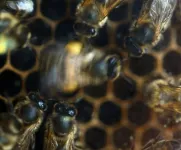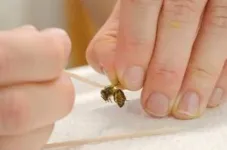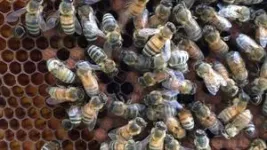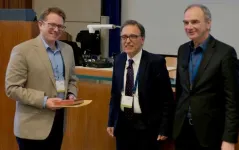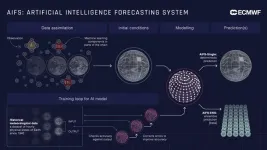(Press-News.org) As far as animals go, honeybees are world-class dancers.
While not as deep and complex as a Super Bowl half-time show, the bees' moves, known as the “waggle" dance, convey very specific food foraging instructions to their nestmates. The direction the dancer moves explains to other bees which way to go, and the duration of the waggle dance, or the “run,” shows how far to go. Once other bees have been convinced to follow the directions, they are “recruited.” After receiving the instructions, these recruits leave the hive to find the food their sisters were so excited about.
Unfortunately, many of these recruited bees do not always successfully find the food they set out in search of. Margaret Couvillon, associate professor in the Department of Entomology in the College of Agriculture and Life Sciences, and her former Ph.D. student Laura McHenry wanted to find out why.
Trying to understand why waggle dances fail
Honeybees have had millions of years to perfect the waggle dance, so it may be surprising to learn that it doesn’t often work. Even though it was first described by scientists over 80 years ago, there is still a lot about the waggle dance that we don’t understand.
Couvillon has learned several interesting patterns related to this form of communication. One such observation was that bees have consistent, unique ways of dancing, meaning each bee has its own “style” that it adds to the communication. Could the success of the waggle dance be related to this uniqueness? Would bees that communicated similarly yield more successful recruits? Or is there some other factor at play? This study reveals the waggle to be a diverse form of communication that helps improve the likelihood that one bee can tell another where food can be found. The findings were recently published in Current Biology.
“Although the waggle dance itself is fascinating, my lab has additionally been intrigued about waggle dance miscommunication, or the hows and whys behind the failure of the dance recruitment,” Couvillon said.
To answer these questions, the Couvillon Lab devised an experiment utilizing clear-walled hives, video cameras, and a method of tagging bees so they could be tracked as individuals when they foraged and danced. Each hive included foragers who had been taught the location of an artificial food source. These trained foragers performed a waggle dance to teach others where this food was, effectively training a new set of recruits. If successful in locating the food, these recruits returned to teach other bees what they learned. Couvillon and her team hypothesized that bees with similar dance styles would more often successfully teach others how to find the food and communication that differed between bees would be less successful.
Whenever a new, tagged bee was observed at the food source, video of the hive was reviewed to determine which dancer had recruited that successful forager. This pattern of data collection allowed the researchers to track the dance the bees used, with each bee learning where the food was located from a slightly different telling. These successful dances were then compiled, and the run of each dance was measured and compared to the earlier dances. The pattern that emerged was not what the researchers expected.
The power of individuality
Based on the data from these dances, Couvillon and McHenry found that similar dance communication did not actually result in the most successful foraging, which was their original hypothesis. Dances that had a longer run, effectively telling the recruits to overshoot the food source, were more successful than dances describing similar, more accurate, distances. This pattern suggested that the “overshooting” instructions may have led to additional opportunities to find the food, once on the way past the food source and again on the way back to the hive. They theorized that the foragers having a second chance to find the food source increased the chance that they find it at all.
What does this mean for understanding the honeybee waggle dance? One takeaway is the importance of these unique communication styles, where individual dance mannerisms enhance communication success. If every bee communicated the same, the likelihood of foragers reaching the food would decrease as compared to having a diverse set of styles.
This study adds effective dance moves to the list of known benefits of individuality, showing that a diverse set of communication skills helps improve the likelihood that one bee can tell another where food can be found, all through dance.
“We’ve known for a while that behavioral and genetic diversity benefit honeybees, allowing for superior thermoregulation, disease resistance, growth, and foraging,” said Couvillon. “Now we have also seen that diverse communication enhances recruitment success.”
The paper, “Individuality impacts communication success in honey bees,” was published in Current Biology. Couvillon’s research was supported by the National Institute of Food and Agriculture, the Foundation for Food and Agriculture Research, and the Department of Entomology at Virginia Tech.
END
Virginia Tech study reveals that honeybee dance ‘styles’ sway food foraging success
Researchers in the Department of Entomology found that the secret to the bees’ success in food gathering is all in the "waggle."
2025-02-25
ELSE PRESS RELEASES FROM THIS DATE:
Beehive sensors offer hope in saving honeybee colonies
2025-02-25
A UC Riverside computer science team has developed a sensor-based technology that could revolutionize commercial beekeeping by reducing colony losses and lowering labor costs.
Called the Electronic Bee-Veterinarian, or EBV, the technology uses low-cost heat sensors and forecasting models to predict when hive temperatures may reach dangerous levels. The system provides remote beekeepers with early warnings, allowing them to take preventive action before their colonies collapse during extreme hot or cold weather or when the bees cannot regulate their hive temperature because of disease, pesticide exposure, food shortages, or other stressors. ...
Award-winning research may unlock universe’s origins
2025-02-25
University of Texas at Arlington physicist Ben Jones has received an international honor for his contributions to developing advanced instruments used in particle physics research.
Dr. Jones, an associate professor of physics, was awarded the 2025 International Committee for Future Accelerators (ICFA) Early Career Researcher Instrumentation Award. Presented by the ICFA Instrumentation Innovation and Development Panel, the award recognizes significant advancements in the innovation and development of new instrumentation for future accelerator experiments.
He accepted the award last week at the 2025 Vienna ...
BRCA1 gene mutations may not be key to prostate cancer initiation, as previously thought
2025-02-25
Mutations in the BRCA1 gene that are either inherited (germline) or acquired (somatic) might not be key to the initiation of prostate cancer, as previously thought, suggests the first study of its kind, published online in the open access journal BMJ Oncology.
If confirmed in further studies, the findings suggest that it may be time to reassess current treatment with PARP (poly(ADP-ribose) polymerase) inhibitor drugs, which block the ability of cells, including cancer cells, to repair DNA damage, in men with BRCA1 genetic variants, say the researchers.
A linked editorial suggests that the findings pave the way for greater refinement of genetic ...
Melatonin supplementation may help offset DNA damage linked to night shift work
2025-02-25
Melatonin supplementation may help offset the DNA damage associated with night shift work by boosting the body’s ability to repair it, suggest the findings of a small clinical trial published online in the journal Occupational & Environmental Medicine.
Larger studies looking at varying doses and the potential long term effects of melatonin supplementation are now warranted, conclude the researchers.
Normal night-time production of the body clock hormone, melatonin, is suppressed in night shift workers. This compromises the body’s ability to repair oxidative DNA damage, the by-product of normal cellular processes, heightening the risk of ...
Common gynaecological disorders linked to raised heart and cerebrovascular disease risk
2025-02-25
Having one or more common gynaecological disorders, such as endometriosis or heavy or irregular periods, may be linked to a heightened risk of heart disease and conditions that affect blood flow to the brain (cerebrovascular disease), finds a pooled data analysis of the available evidence published online in the journal Heart.
Although the quality of the studies included in the analysis was variable, the researchers nevertheless conclude that clinicians and the public need to be more aware of these associations to potentially mitigate the risks.
Long term non-cancerous gynaecological disorders ...
Nerve fibers in the inner ear adjust sound levels and help compensate for hearing loss in mice, study finds
2025-02-25
The brain may play a role in helping the ear regulate its sensitivity to sound and compensate for hearing loss by sending a signal to a structure in the inner ear known as the cochlea, according to a study that was just published in the Journal of Neuroscience. The discovery could help researchers develop treatments for tough-to-treat hearing disorders such as hyperacusis, where everyday sounds seem uncomfortably loud, and tinnitus, a sensation of ringing, buzzing or other sound in the ear when there is no external source.
The findings were powered by a new ...
ECMWF – Europe’s leading centre for weather prediction makes forecast data from AI model available to all
2025-02-25
Embargo: 25 February 2025 00.01 AM GMT
ECMWF – Europe’s leading centre for weather prediction makes forecast data from AI model available to all
A newly operational model, known as the Artificial Intelligence Forecasting System (AIFS), has been launched by the European Centre for Medium-Range Weather Forecasts (ECMWF), an intergovernmental centre and leader in numerical weather prediction. For many measures including tropical cyclone tracks, the AIFS outperforms state-of-the-art physics-based models, with gains ...
New paper-based device boosts HIV test accuracy from dried blood samples
2025-02-24
In parts of the world where traveling to a clinic for routine blood tests is a financial and logistical challenge, HIV patients increasingly have the option to collect and ship a drop of their blood in paper-based devices that absorb the sample and store it for analysis in far-away labs.
While this technology is helpful for tracking someone’s adherence to their drug regimen or monitoring disease progression, the most frequently used devices don’t control how much blood they collect, potentially leading to inaccurate readings of a person’s infection.
Understanding this limitation, Charlie Mace, an associate professor at Tufts University’s ...
Pay-for-performance metrics must be more impactful and physician-controlled
2025-02-24
Pay-for-Performance Metrics Must Be More Impactful and Physician-Controlled
Background: This editorial builds on a study by Brulin and Teoh, released ahead of the March/April 2025 issue of Annals of Family Medicine, which found that performance-based reimbursement is associated with lower perceived quality of care by increasing illegitimate tasks and moral distress for primary care physicians.
Editorial Stance: Quality metrics and pay-for-performance initiatives are far more expensive than many patients, clinicians, or administrators realize. The authors call for more rigorous review through cluster randomized controlled trials both before and after implementation—and ...
GLP-1RAs may offer modest antidepressant effects compared to DPP4is but not SGLT-2is
2025-02-24
Follow @Annalsofim on X, Facebook, Instagram, threads, and Linkedin
Below please find summaries of new articles that will be published in the next issue of Annals of Internal Medicine. The summaries are not intended to substitute for the full articles as a source of information. This information is under strict embargo and by taking it into possession, media representatives are committing to the terms of the embargo not only on their own behalf, but also on behalf of the organization they represent.
----------------------------
1. ...
LAST 30 PRESS RELEASES:
NTP-enhanced lattice oxygen activation in Ce-Co catalysts for low-temperature soot combustion
Synergistic interface engineering in Cu-Zn-Ce catalysts for efficient CO2 hydrogenation to methanol
COVID-19 leaves a lasting mark on the human brain
Scientists use ultrasound to soften and treat cancer tumors without damaging healthy tissue
Community swimming program for Black youth boosts skills, sense of belonging, study finds
Specific depressive symptoms in midlife linked to increased dementia risk
An ‘illuminating’ design sheds light on cholesterol
Who is more likely to get long COVID?
Study showcases resilience and rapid growth of “living rocks”
Naval Research Lab diver earns Office of Naval Research 2025 Sailor of the Year
New Mayo-led study establishes practical definition for rapidly progressive dementia
Fossil fuel industry’s “climate false solutions” reinforce its power and aggravate environmental injustice
Researchers reveal bias in a widely used measure of algorithm performance
Alcohol causes cancer. A study from IOCB Prague confirms damage to DNA and shows how cells defend against it
Hidden viruses in wastewater treatment may shape public health risks, study finds
Unlock the power of nature: how biomass can transform climate mitigation
Biochar reshapes hidden soil microbes that capture carbon dioxide in farmland
Reducing saturated fat intake shows mortality benefit, but only in high-risk individuals
Manta rays create mobile ecosystems, study finds
Study: Mixed results in using lipoic acid to treat progressive multiple sclerosis
Norbert Holtkamp appointed director of Fermi National Accelerator Laboratory
New agentic AI platform accelerates advanced optics design
Biologists discover neurons use physical signals — not electricity — to stabilize communication
Researchers discover that a hormone can access the brain by hitchhiking
University of Oklahoma researcher awarded funding to pursue AI-powered material design
Exploring how the visual system recovers following injury
Support for parents with infants at pediatric check-ups leads to better reading and math skills in elementary school
Kids’ behavioral health is a growing share of family health costs
Day & night: Cancer disrupts the brain’s natural rhythm
COVID-19 vaccination significantly reduces risk to pregnant women and baby
[Press-News.org] Virginia Tech study reveals that honeybee dance ‘styles’ sway food foraging successResearchers in the Department of Entomology found that the secret to the bees’ success in food gathering is all in the "waggle."
